Design and Analysis for Multi-Layered Elastomeric Bearing on Rotor Hub Considering Large Axial Load and Nonlinear Motion
Abstract
:1. Introduction
2. Characteristics of Elastomer
2.1. Design of Elastomeric Bearing
- (a)
- Determination of external dimensions and target performance and rigidity
- (b)
- Selection of appropriate strain for marginal life expectancy
- (c)
- Calculation of apparent modulus of elastomericity between layers with marginal strain
- (d)
- Calculation of shape coefficient from shear modulus and apparent modulus of elastomericity of polymer materials
- (e)
- Calculation of Thickness of Interlayer Polymer Materials from Shape Coefficients
- (f)
- Calculation of strain for stiffness and operating spectrum from established thickness and physical properties
- (g)
- Detailed Design Using Target Performance Comparison and Finite Element Analysis
2.2. Laminated Rubber Properties of Elastomeric Bearing

2.3. Manufacturing Process of Elastomeric Bearing
3. Design of Elastomeric Bearing Considering Large Load and Nonlinear Motion
3.1. Configuration of Elastomeric Bearing
3.2. Calculation Mooney-Rivlin Constant Value of Laminated Rubber
3.3. Sizing Equation of Elastomeric Bearing Structure
4. Structural Analysis of Elastomeric Bearing
4.1. Structural Analysis Results of Elastomeric Bearing
4.2. Structural Analysis Results of Elastomeric Bearing in Helicopter Flight Environment
4.3. Nonlinear Motion Results of Elastomeric Bearing
5. Conclusions
Author Contributions
Funding
Institutional Review Board Statement
Informed Consent Statement
Data Availability Statement
Conflicts of Interest
References
- Schapery, R.A.; Skala, D.P. Elastomeric stability of laminated elastomeric columns. Int. J. Solids Struct. 1976, 12, 401–417. [Google Scholar] [CrossRef]
- Simo, J.C.; Kelly, J.M. Finite element analysis of the stability of multilayer elastomeric bearings. Eng. Struct. 1984, 6, 162–174. [Google Scholar] [CrossRef]
- Jeong, J.-G.; Kim, Y.-S.; Park, G.-R.; Kim, D.-H.; Lee, M.-G.; Kim, D.-K. An Experimental Study for Material Properties of Elastomer Bearing Using Next Genration Helicopter Rotor System; Korean Society for Noise and Vibration Engineering (KSNVE): Seoul, Republic of Korea, 2003. [Google Scholar]
- Topkaya, C. Analysis of specimen size effects in inclined compression test on laminated elastomeric bearings. Eng. Struct. 2004, 26, 1071–1080. [Google Scholar] [CrossRef]
- Nasdala, L.; Hohn, B.; Rühl, R. Design of end-plate connections with elastomeric intermediate layer. J. Constr. Steel Res. 2007, 63, 494–504. [Google Scholar] [CrossRef]
- Taeju, K.; Seungho, K.; Inhui, H.; Gyeongmun, B.; Jeongho, H. Establishment elastomer bearing & lead-lag damper requirements for helicopter main rotor. Int. J. Aeronaut. Space Sci. 2008, 731–734. [Google Scholar]
- Lee, W.-H.; Lim, H.-J.; Jo, H.-J.; Oh, J.; Park, K.-R. A Study on The Shape Design and Finite Element Analysis of Elastomer Bearing for Helicopter Rotor System; The Korean Society for Aeronautical & Space Sciences: Seoul, Republic of Korea, 2008. [Google Scholar]
- Kim, H.D.; Yoo, S.Y.; Park, J.S. Design of an Elastomeric Bearing for a Helicopter Rotor Hub by Non-linear Finite Element Method. J. Korean Soc. Aeronaut. Space Sci. 2010, 38, 612–619. [Google Scholar]
- Kim, D.K.; Yun, C.Y.; Song, K.W.; Kim, S.B.; Kim, S.H. Current Technology Status of Bearingless Rotor Hub system for Helicopter. Curr. Ind. Technol. Trends Aerosp. 2010, 8, 118–130. [Google Scholar]
- Gonca, V.; Polukoshko, S.; Boyko, A. Analytical and Experimental Research of Compressive Stiffness for Laminated Elastomeric Structures. Procedia Eng. 2014, 69, 1388–1396. [Google Scholar] [CrossRef]
- Osgooei, P.M.; Tait, M.J.; Konstantinidis, D. Three-dimensional finite element analysis of circular fiber-reinforced elastomeric bearings under compression. Compos. Struct. 2014, 108, 191–204. [Google Scholar] [CrossRef]
- Gajewski, M.; Szczerba, R.; Jemioło, S. Modelling of Elastomeric Bearings with Application of Yeoh Hyperelastomeric Material Model. Procedia Eng. 2015, 111, 220–227. [Google Scholar] [CrossRef]
- Jin, Y.; Yu, L.; Yong, L. Vibration Reduction of a Bearingless Helicopter Rotor with Composite Tailored Couplings. Procedia Eng. 2015, 99, 1372–1379. [Google Scholar] [CrossRef]
- Wei, W.; Yuan, Y.; Igarashi, A.; Tan, P.; Iemura, H.; Zhu, H. A generalized rate-dependent constitutive law for elastomeric bearings. Constr. Build. Mater. 2016, 106, 693–699. [Google Scholar] [CrossRef]
- Zaimova, D.; Bayraktar, E.; Miskioglu, I. Design and manufacturing of new elastomeric composites: Mechanical properties, chemical and physical analysis. Compos. Part B Eng. 2016, 105, 203–210. [Google Scholar] [CrossRef]
- Ahmadipour, M.; Alam, M.S. Sensitivity analysis on mechanical characteristics of lead-core steel-reinforced elastomeric bearings under cyclic loading. Eng. Struct. 2017, 140, 39–50. [Google Scholar] [CrossRef]
- Kalfas, K.N.; Mitoulis, S.A.; Katakalos, K. Numerical study on the response of steel-laminated elastomeric bearings subjected to variable axial loads and development of local tensile stresses. Eng. Struct. 2017, 134, 346–357. [Google Scholar] [CrossRef]
- Rastgoo, M.S.; Konstantinidis, D. Finite element study of the effect of support rotation on the horizontal behavior of elastomeric bearings. Compos. Struct. 2017, 163, 474–490. [Google Scholar] [CrossRef]
- Schapery, R.A. Elastomeric bearing sizing analysis Part 1: Spherical bearing. Int. J. Solids Struct. 2018, 152–153, 118–139. [Google Scholar] [CrossRef]
- Schapery, R.A. Elastomeric bearing sizing analysis Part 2: Flat and cylindrical bearings. Int. J. Solids Struct. 2018, 152–153, 140–150. [Google Scholar] [CrossRef]
- Kazeminezhad, E.; Kazemi, M.T.; Mirhosseini, S.M. Assessment of the vertical stiffness of elastomeric bearing due to displacement and rotation. Int. J. Non-Linear Mech. 2020, 119, 103306. [Google Scholar] [CrossRef]
- Nageswara Rao, P.; Manoj Kumar, N.; Padmanaban, S.; Subathra, M.S.P.; Chand, A. A Novel Sensorless Approach for Speed and Displacement Control of Bearingless Switched Reluctance Motor. Appl. Sci. 2020, 10, 4070. [Google Scholar] [CrossRef]
- Pauletta, M.; Pinzano, F.; Frappa, G.; Russo, G. Tensile Tests for the Improvement of Adhesion between Rubber and Steel Layers in Elastomeric Isolators. Appl. Sci. 2020, 10, 8063. [Google Scholar] [CrossRef]
- Mazza, F.; Mazza, M. Influence of Elastomeric Bearings in Tension on the Seismic Performance of Base-Isolated r.c. Buildings. Appl. Sci. 2021, 11, 82. [Google Scholar] [CrossRef]
- Mohamedmeki, Z.M.; Esmail, F.J.; Ajeel, E.A. Fatigue life analysis of laminated elastomeric bearing pad. Mater. Today Proc. 2021, 42, 2361–2368. [Google Scholar] [CrossRef]
- Sun, G.; Wu, M.; Yang, Y.; Xue, S. Mechanical properties of radial spherical plain bearing (RSPB) joint with an inserted plate for building structural application—An experimental study. Structures 2021, 33, 2140–2151. [Google Scholar] [CrossRef]
- Erduran, E.; Nordli, C.; Gonen, S. Effect of Elastomeric Bearing Stiffness on the Dynamic Response of Railway Bridges Considering Vehicle. Bridge Interact. 2022, 12, 11952. [Google Scholar] [CrossRef]
- Fink, A.; Schatz, R. Structurally integrated constrained layer damping for noise reduction on sandwich and semi-monocoque helicopter structures. Compos. Struct. 2023, 322, 117354. [Google Scholar] [CrossRef]
- Rejith, R.; Kesavan, D.; Chakravarthy, P.; Narayana, M.S. Bearings for aerospace applications. Tribol. Int. 2023, 181, 108312. [Google Scholar] [CrossRef]
- Wu, H.; Wang, Z.; Zhang, Q.; Sui, W. Mechanical performance of an elastomeric bearing incorporated within steel ring restrainers. Structures 2023, 52, 117–130. [Google Scholar] [CrossRef]
- Paridie, A.; Ene, N. Theoretical study of effect of the geometrical parameters on the dynamic properties of the elastomeric rings of an air journal bearing. Heliyon 2023, 9, 16129. [Google Scholar] [CrossRef]
- Rivlin, R.S. Large elastomeric deformations of isotropic materials IV. Further develpments of the general theory. Phil. Trans. A 1948, 241, 379–397. [Google Scholar]
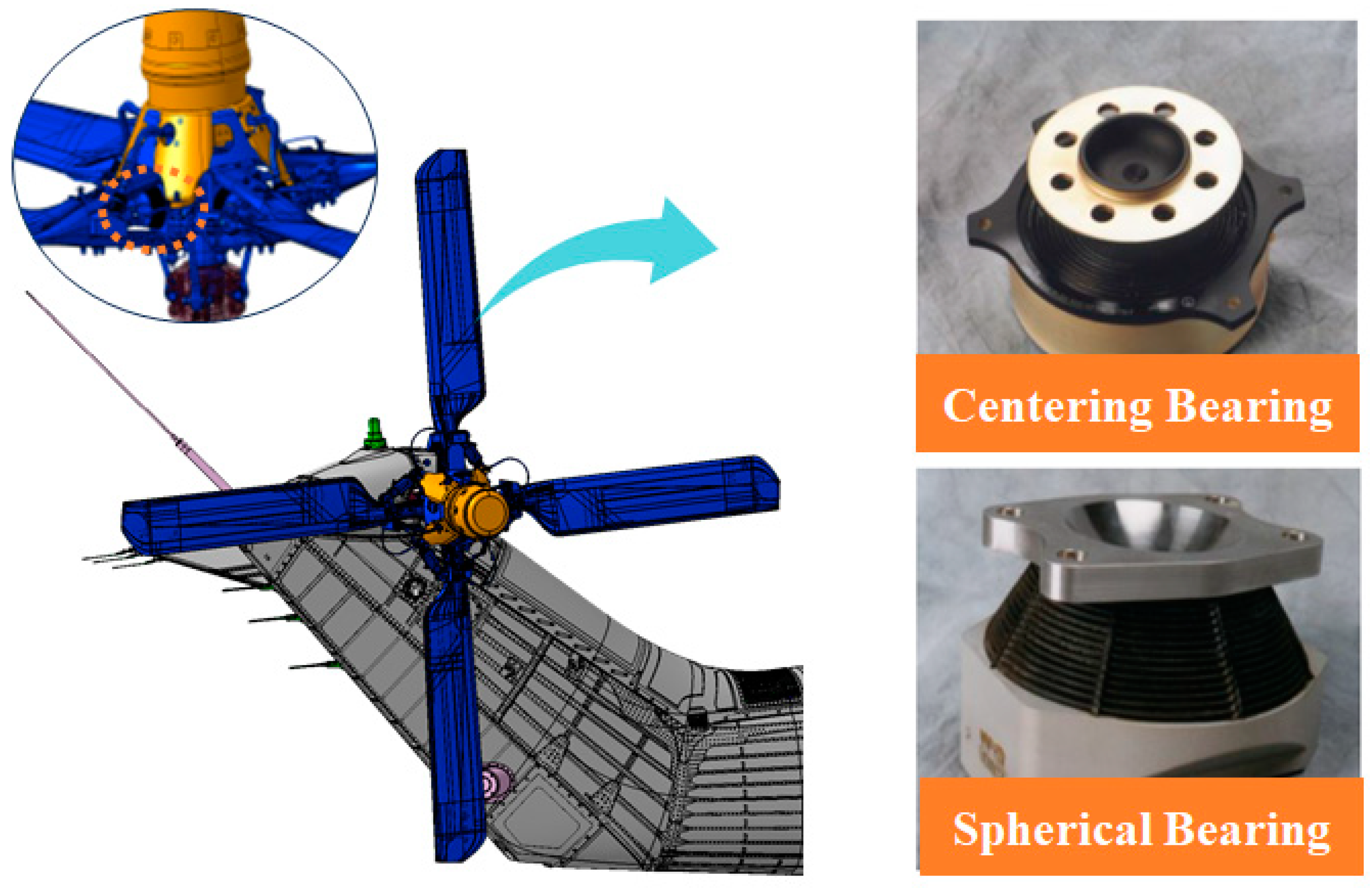


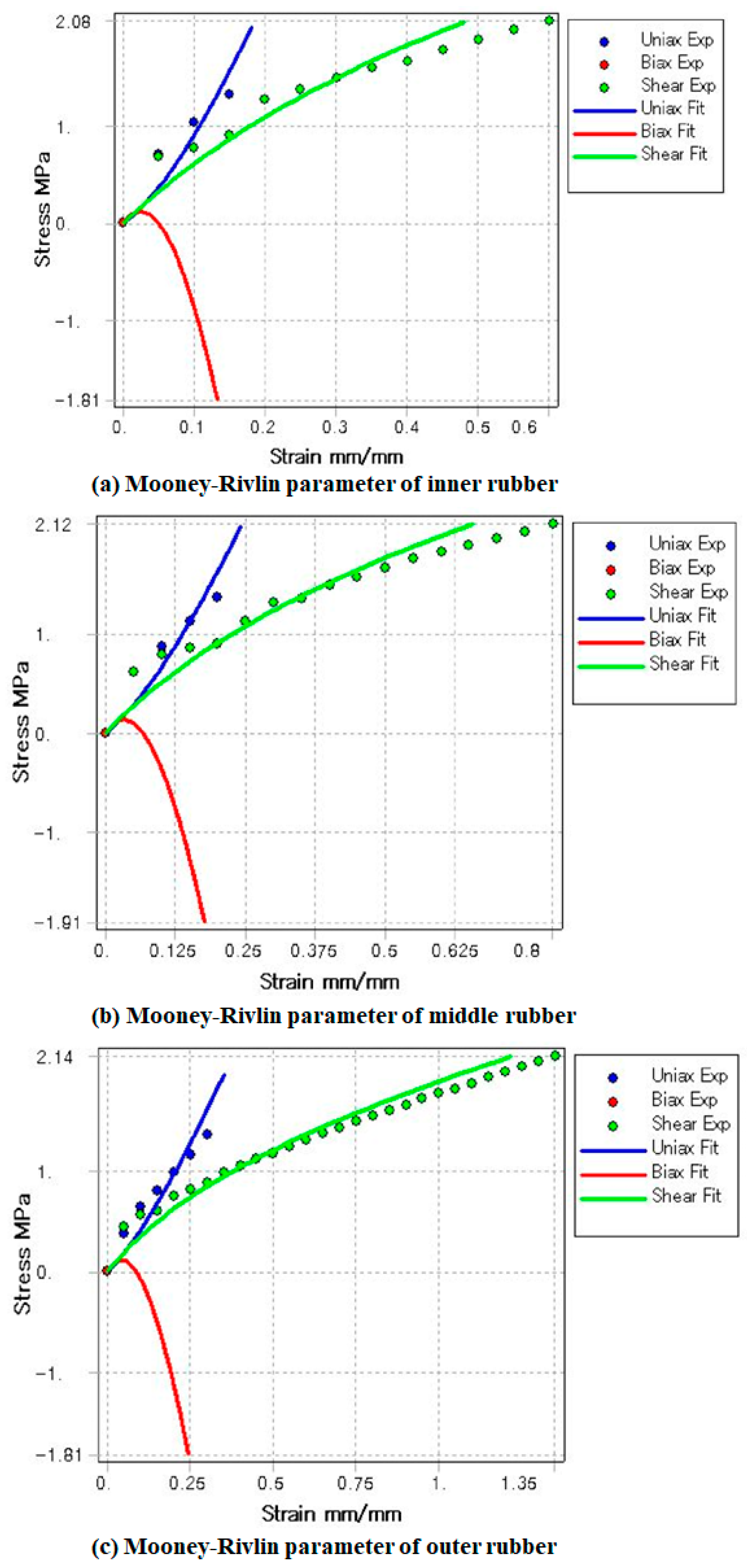
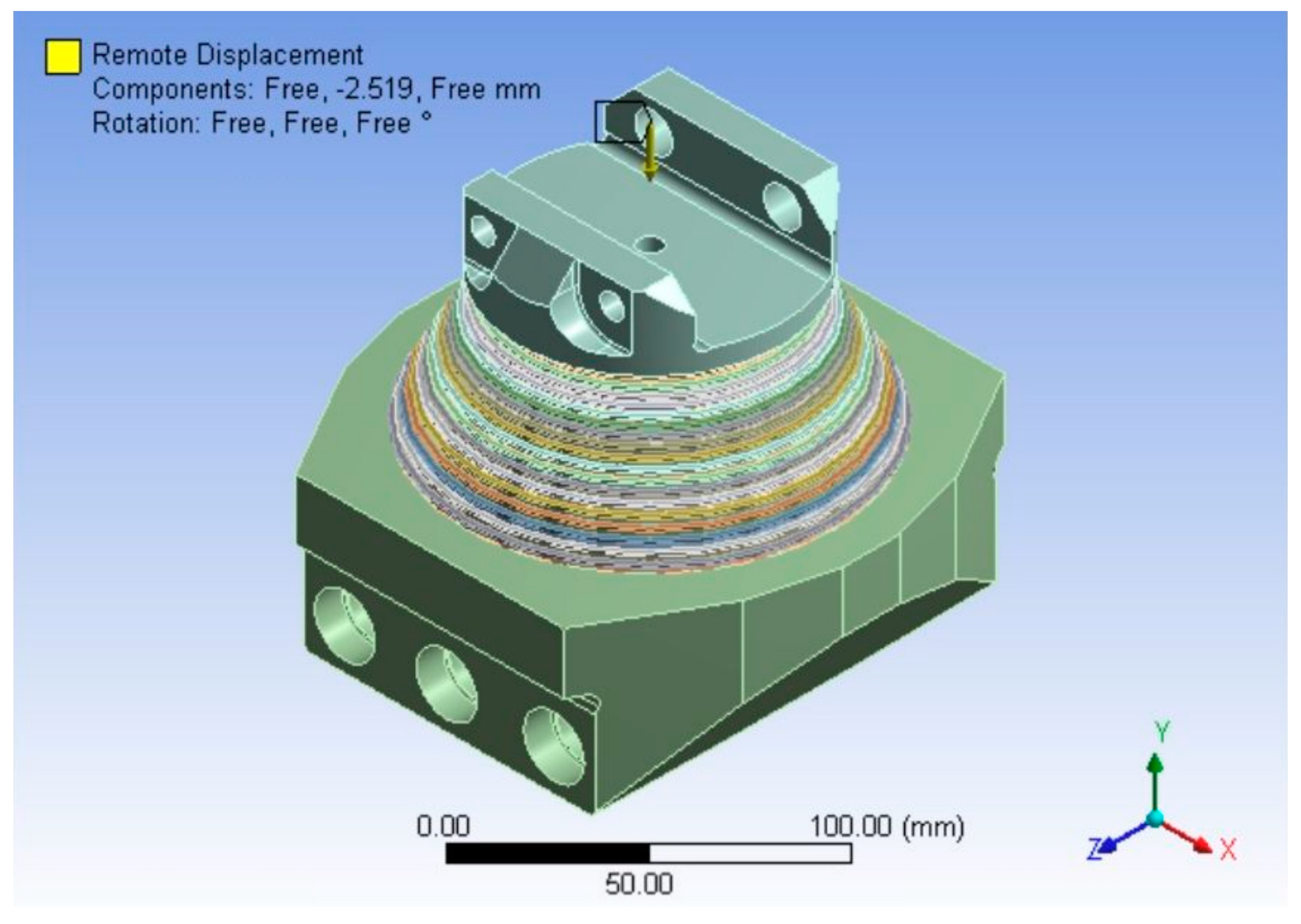
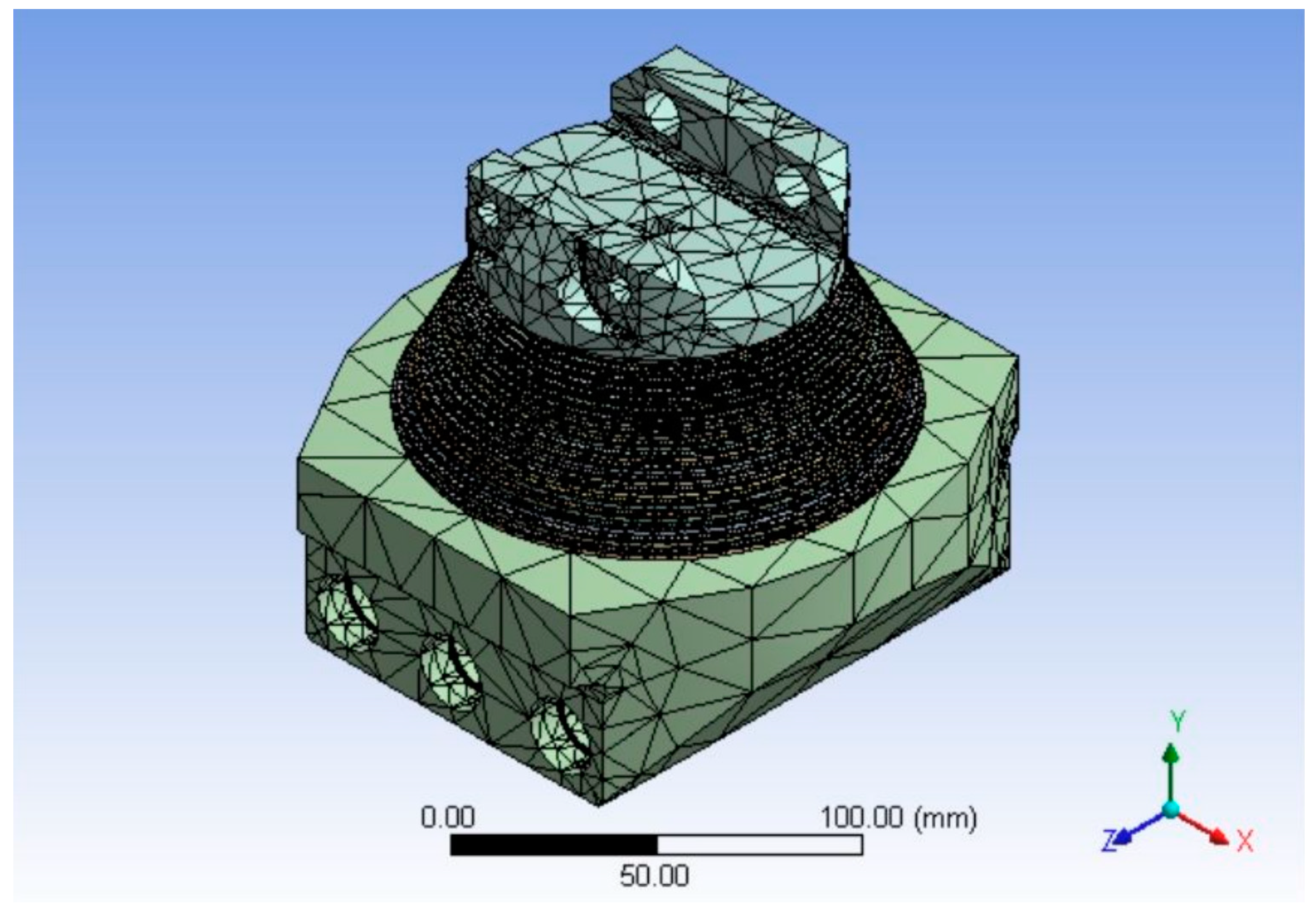

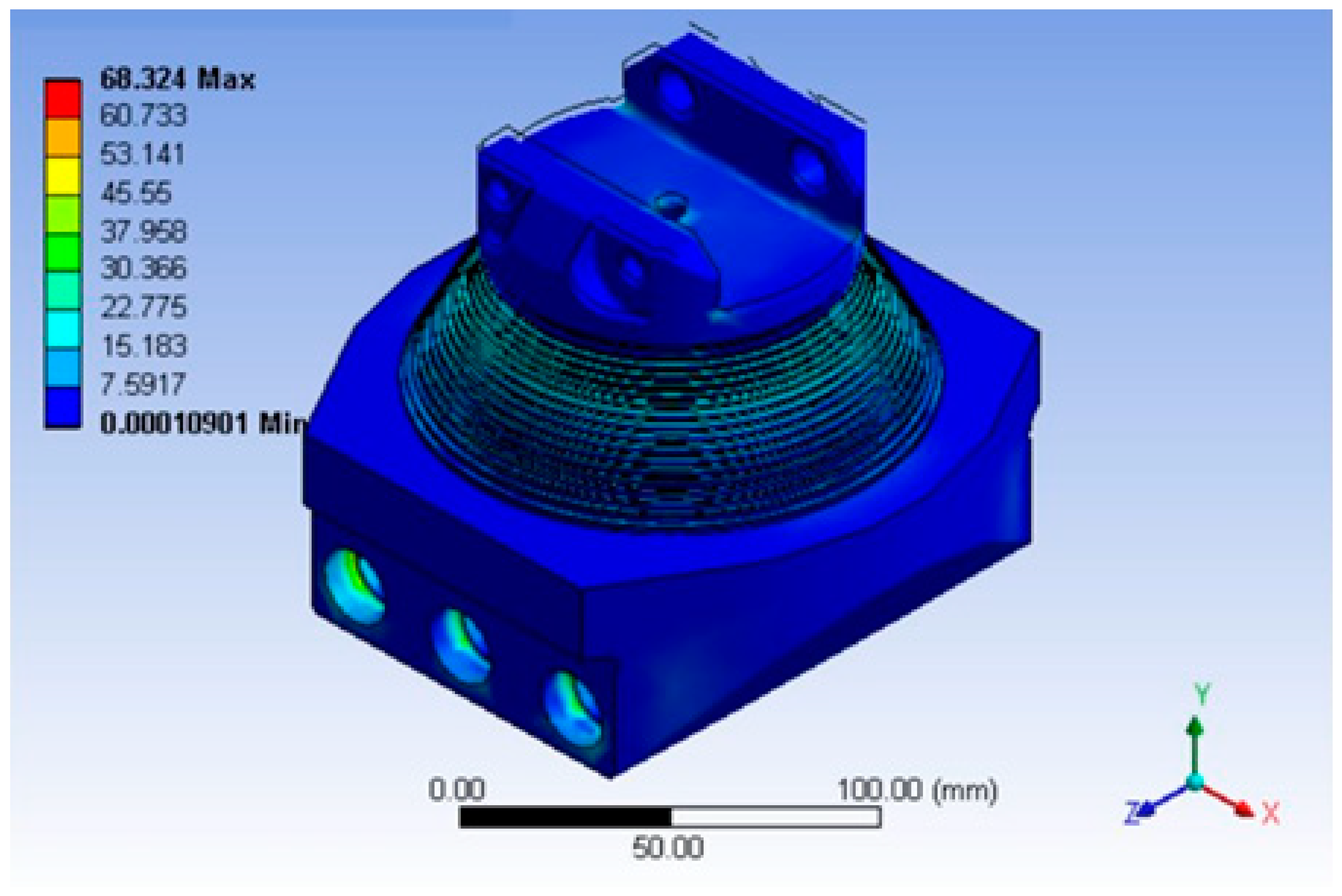
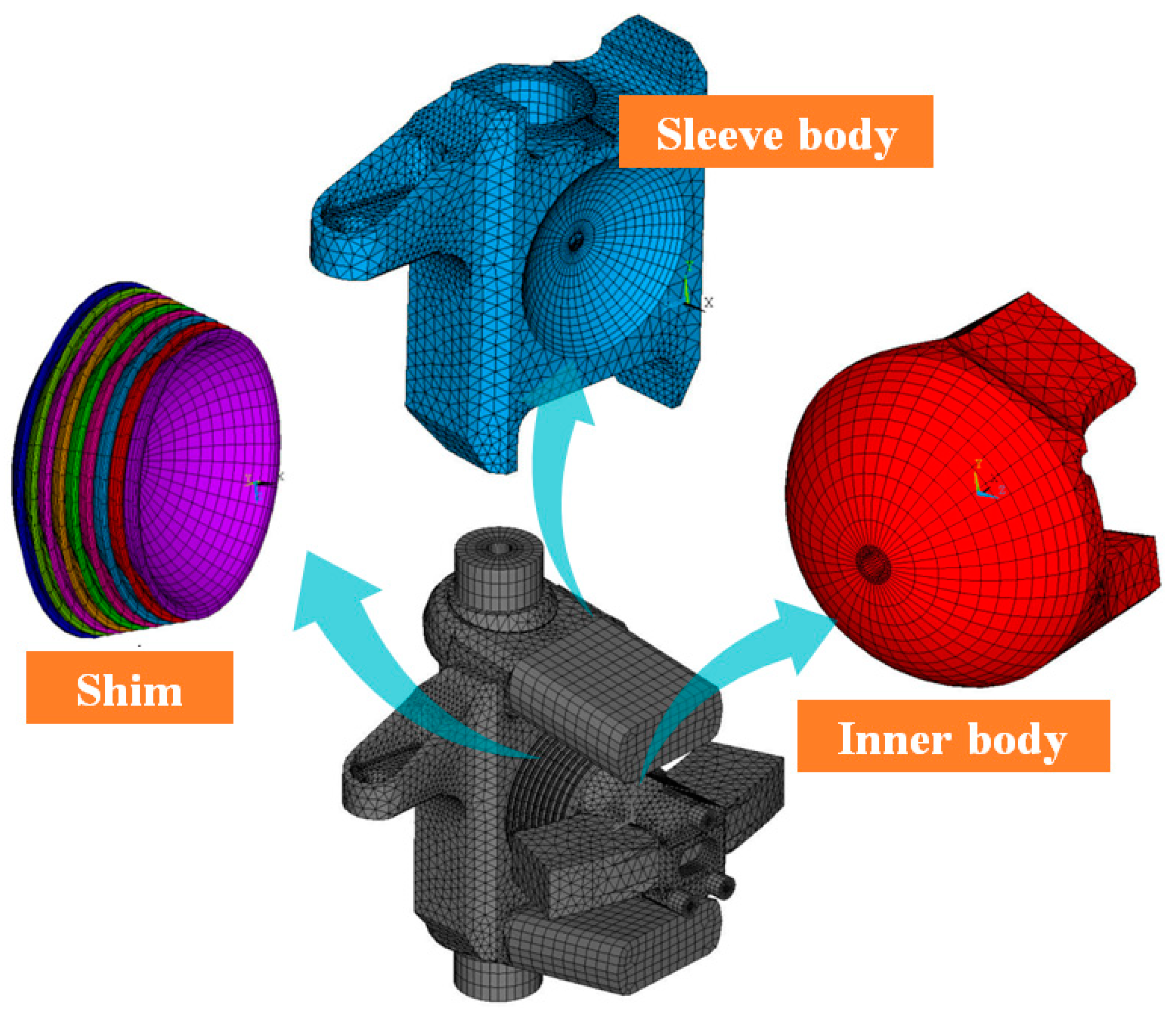
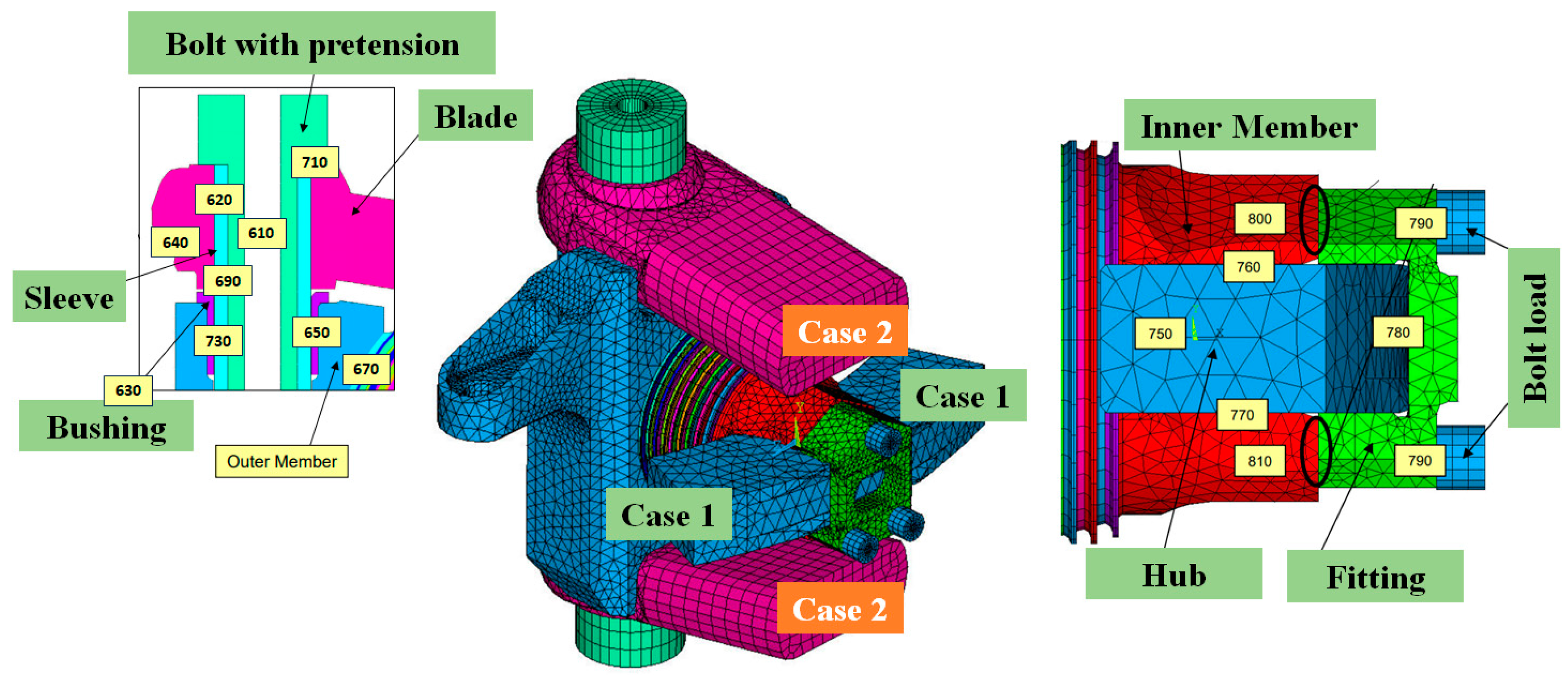
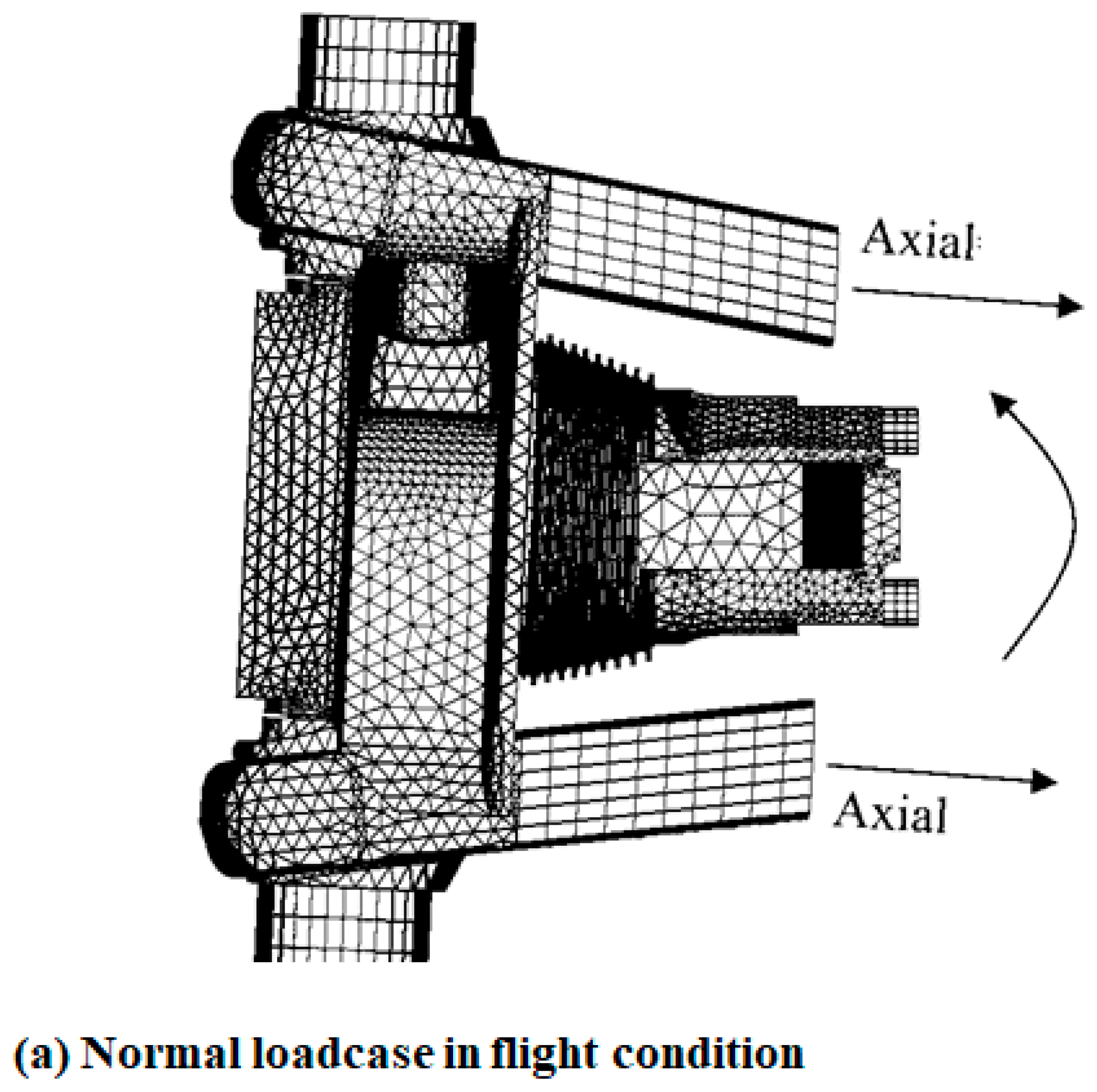

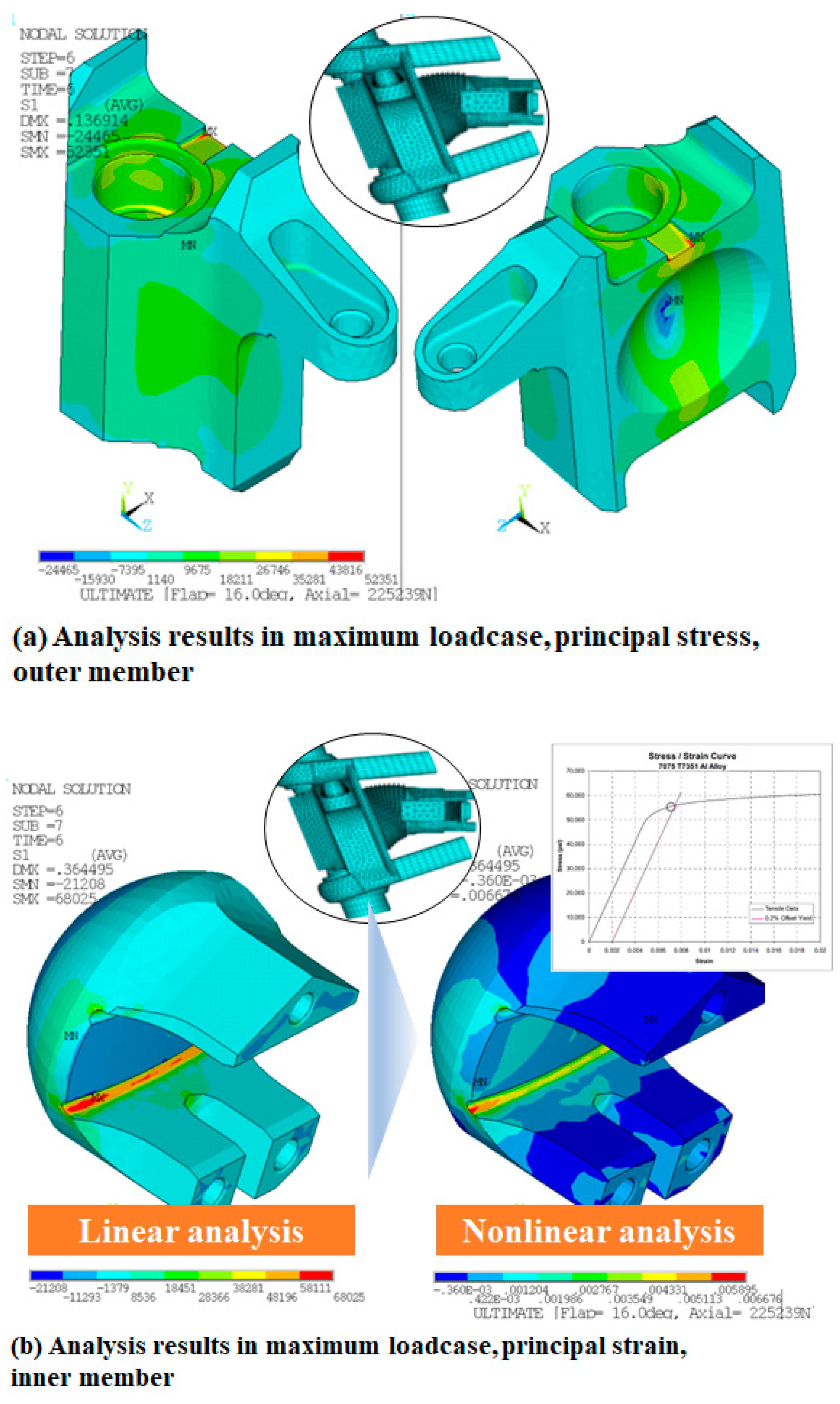
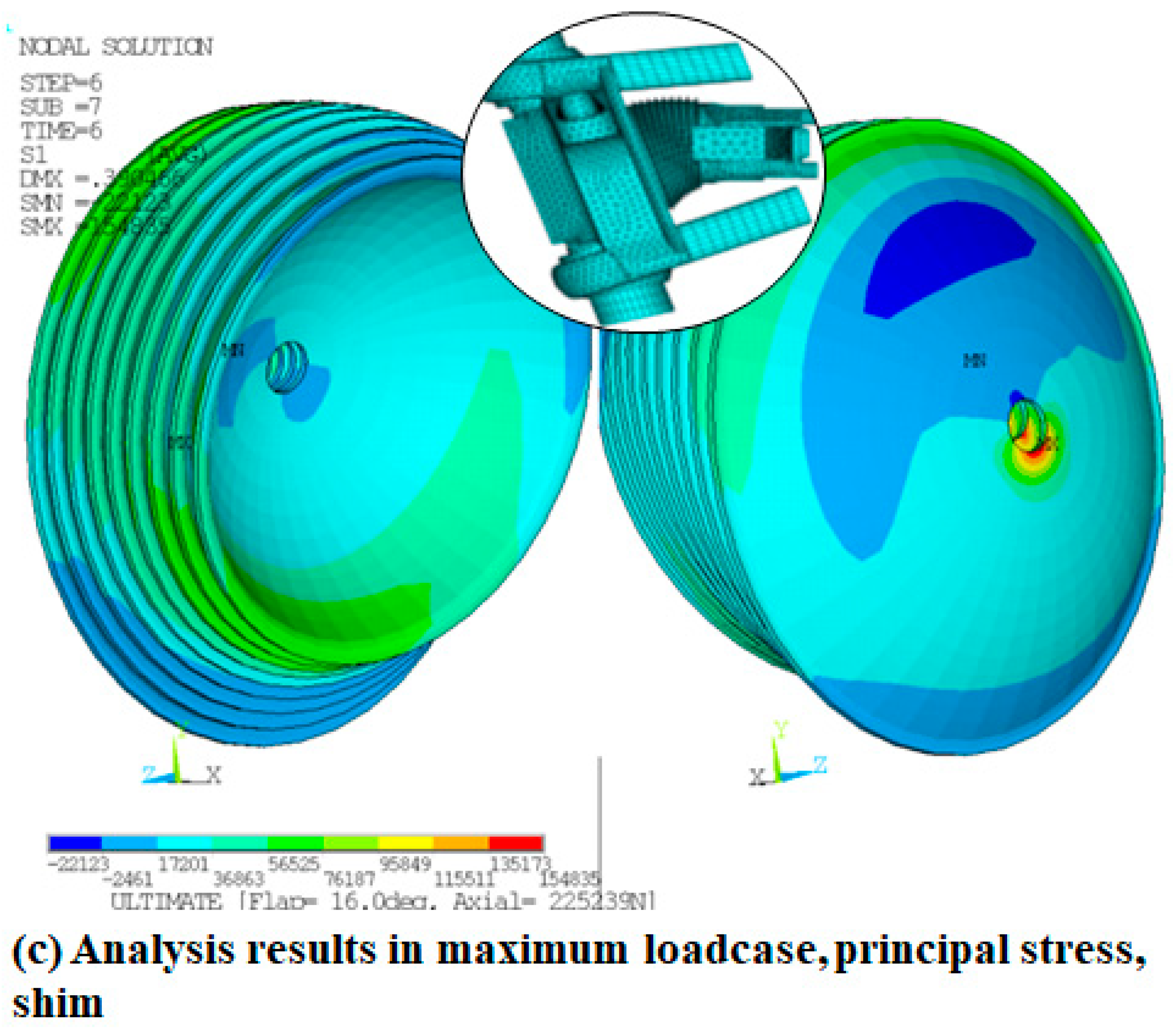
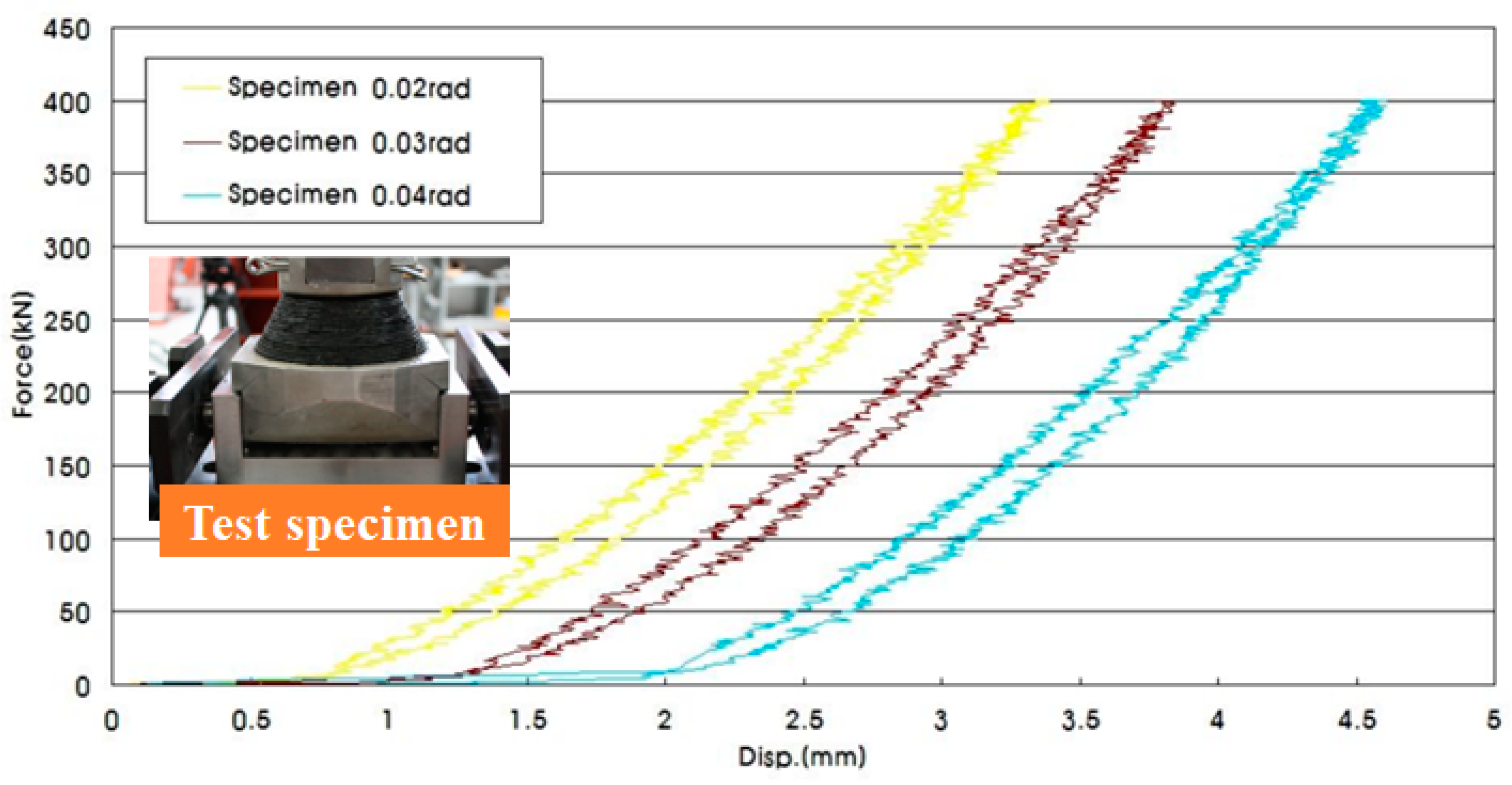
| Hub Type | (a) | (b) |
|---|---|---|
| Hinge and Bearing Number | Hinge/Bearing Type, Number | |
| Articulated | 3 EA Flapping/Lead-lag/Feathering | Three separated hinge 2~3 elastomeric bearing |
| Advanced Articulated Elastomeric bearing | 3 EA Flapping/Lead-lag/Feathering | One spherical elastomeric bearing |
| Hingeless | 1 EA Feathering | Mechanical hinge Elastomeric bearing |
| Bearingless | None | Flexbeam/Torque tube |
| Test Item | Outer Part | Middle Part | Inner Part | Spec |
|---|---|---|---|---|
| Hardness | 61 | 72.5 | 76 | ISO 7619 |
| Tensile Strength (MPa) | 28.5 | 26.1 | 25.3 | ISO 37 |
| Elongation | 685 | 605 | 577 | ISO 37 |
| Test Item | Simbol | Radius of Rotation of Elastomeric Bearing |
|---|---|---|
| Inner Radius | Rinner | 64.2 mm |
| Middle Radius | Rmiddle, Rinner | 78.2 mm |
| Rmiddle, Router | 95.3 mm | |
| Outer Radius | Router | 112.2 mm |
| Constant | C10 | C01 | C11 | d |
|---|---|---|---|---|
| Inner | 9.4455 | −8.5627 | 0.024736 | 3.32112 × 10−5 |
| Middle | 6.0675 | −5.3327 | 0.014719 | 6.93063 × 10−5 |
| Outer | 3.2575 | −2.7553 | 0.034433 | 2.98067 × 10−5 |
| Boundary Contact Number | Coefficient of Friction μ | Boundary Location |
|---|---|---|
| 610–620 | Bonded | Blade, sleeve to bolt |
| 630–640 | 0.1 | Blade to bushing |
| 650–660 | 0.1 | Bushing to outer member |
| 670–680 | 0.1 | Interference fit, bushing to outer member |
| 690–700 | Bonded | Sleeve to bolt |
| 710–720 | Bonded | Blade to bolt |
| 730–740 | 0.1 | Bushing to sleeve (radial) |
| 750 | 0.1 | Inner member to hub (axial) |
| 760–770 | 0.1 | Inner member to hub (top/bottom flat) |
| 780 | Bonded | Hub to fitting |
| 790 | Bonded | Fitting to bolt heads |
| 800–810 | Bonded | Inner member to bolts |
| 820–830 | 0.1 | Outer member to torsion bolt |
Disclaimer/Publisher’s Note: The statements, opinions and data contained in all publications are solely those of the individual author(s) and contributor(s) and not of MDPI and/or the editor(s). MDPI and/or the editor(s) disclaim responsibility for any injury to people or property resulting from any ideas, methods, instructions or products referred to in the content. |
© 2023 by the authors. Licensee MDPI, Basel, Switzerland. This article is an open access article distributed under the terms and conditions of the Creative Commons Attribution (CC BY) license (https://creativecommons.org/licenses/by/4.0/).
Share and Cite
Jang, J.-H.; Ahn, S.-H. Design and Analysis for Multi-Layered Elastomeric Bearing on Rotor Hub Considering Large Axial Load and Nonlinear Motion. Appl. Sci. 2023, 13, 12715. https://doi.org/10.3390/app132312715
Jang J-H, Ahn S-H. Design and Analysis for Multi-Layered Elastomeric Bearing on Rotor Hub Considering Large Axial Load and Nonlinear Motion. Applied Sciences. 2023; 13(23):12715. https://doi.org/10.3390/app132312715
Chicago/Turabian StyleJang, Jun-Hwan, and Sang-Ho Ahn. 2023. "Design and Analysis for Multi-Layered Elastomeric Bearing on Rotor Hub Considering Large Axial Load and Nonlinear Motion" Applied Sciences 13, no. 23: 12715. https://doi.org/10.3390/app132312715
APA StyleJang, J.-H., & Ahn, S.-H. (2023). Design and Analysis for Multi-Layered Elastomeric Bearing on Rotor Hub Considering Large Axial Load and Nonlinear Motion. Applied Sciences, 13(23), 12715. https://doi.org/10.3390/app132312715






